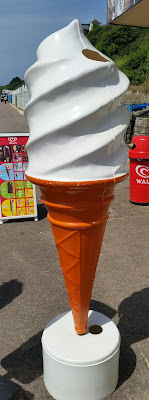Put the words BEACH and PLASTICS in the same sentence and
thoughts go immediately to the current issues of plastics pollution and the
damage to the marine environment caused by the improper disposal of single use
plastics. But there is a happier way to consider plastics and the beach as I
found during a recent morning walk along Bournemouth’s sea front.
This one sadly missing its chocolate flake, possibly removed by an over exuberant holidaymaker. Generally made from poly-resin and glass-fibre, models such as these are expected to stand up to the vagaries of the English summer weather.
Further along the prom I came across a lovely, colourful
display of beach toys for sale.
Buckets, spades, starfish and shell shaped moulds etc. too good
to leave behind after a busy day of sand sculpting and shell collecting. Made
from lightweight and robust polyethylene and polypropylene such toys are far
safer than the ones on offer that I remember as a child. Bare toes were particularly vulnerable when
digging with a metal spade.
At the same kiosk were containers of brightly coloured
windmills for children, made
from weather resistant flexible polyester film, and racks of inexpensive
sunglasses with acrylic or polycarbonate lenses and lightweight frames, in an
inexhaustible range of styles and colours, hopefully offering some protection
from the harmful sun’s rays.
Next up was the ubiquitous deck chair.
Suspended
from the traditional folding wooden frame, the striped polyester canvas
material, protected from the worst of the weather with a polyurethane coating
and treated to resist the effects of UV light, it offers some degree of comfort
to those wanting to avoid sitting on the sand.
Talking of sitting on the sand – a neat stack of sun loungers
waiting for customers resembled some sort of weird sculpture created by the
repetitious form of their moulded polypropylene frames.
And to top it all off, a giant glass fibre resin penguin to
advertise the recent addition of a penguin enclosure at the Oceanarium, a visit
to which might make one reflect on the importance of the safe and proper
disposal of our unwanted plastics.
Pam Langdown (Collections Manager)













